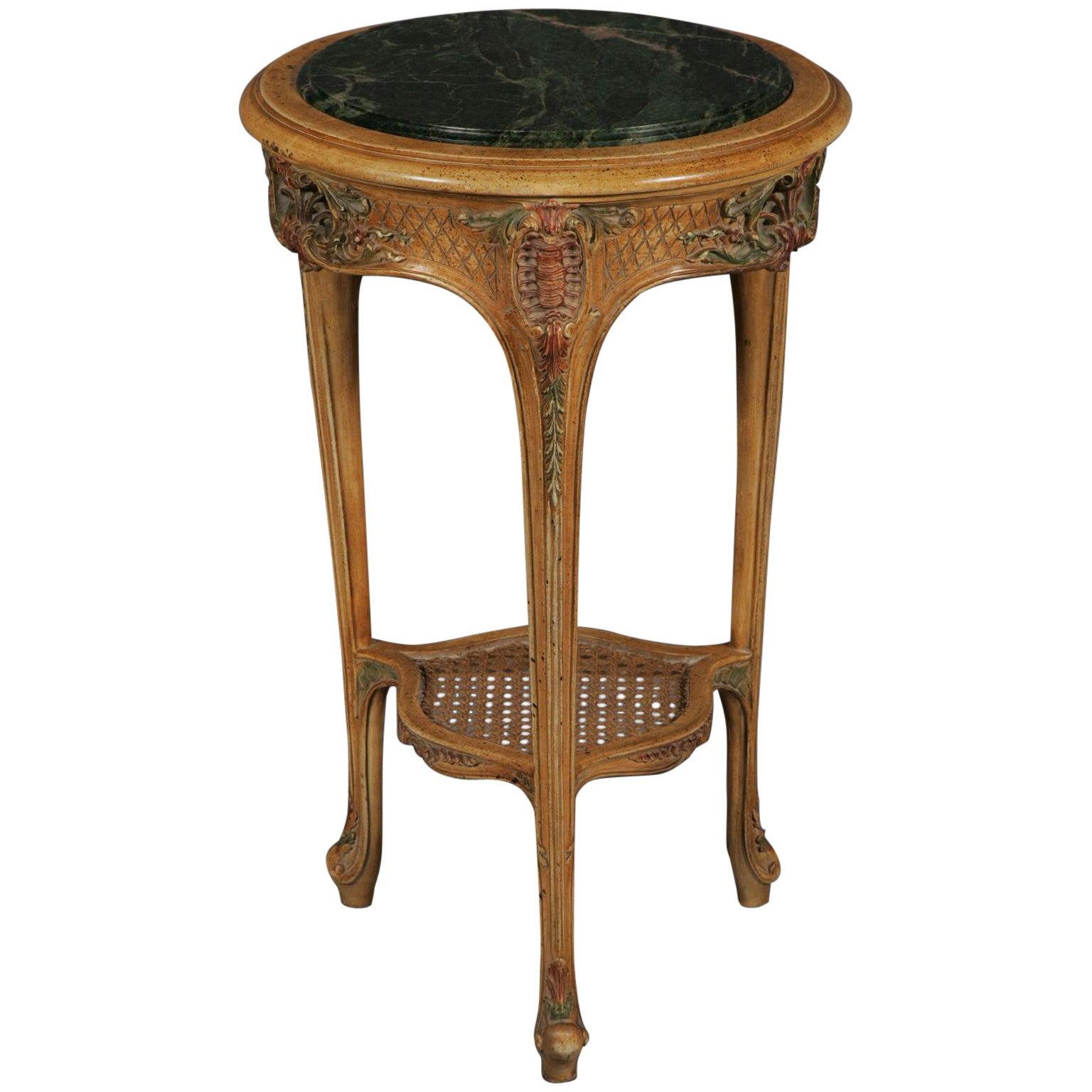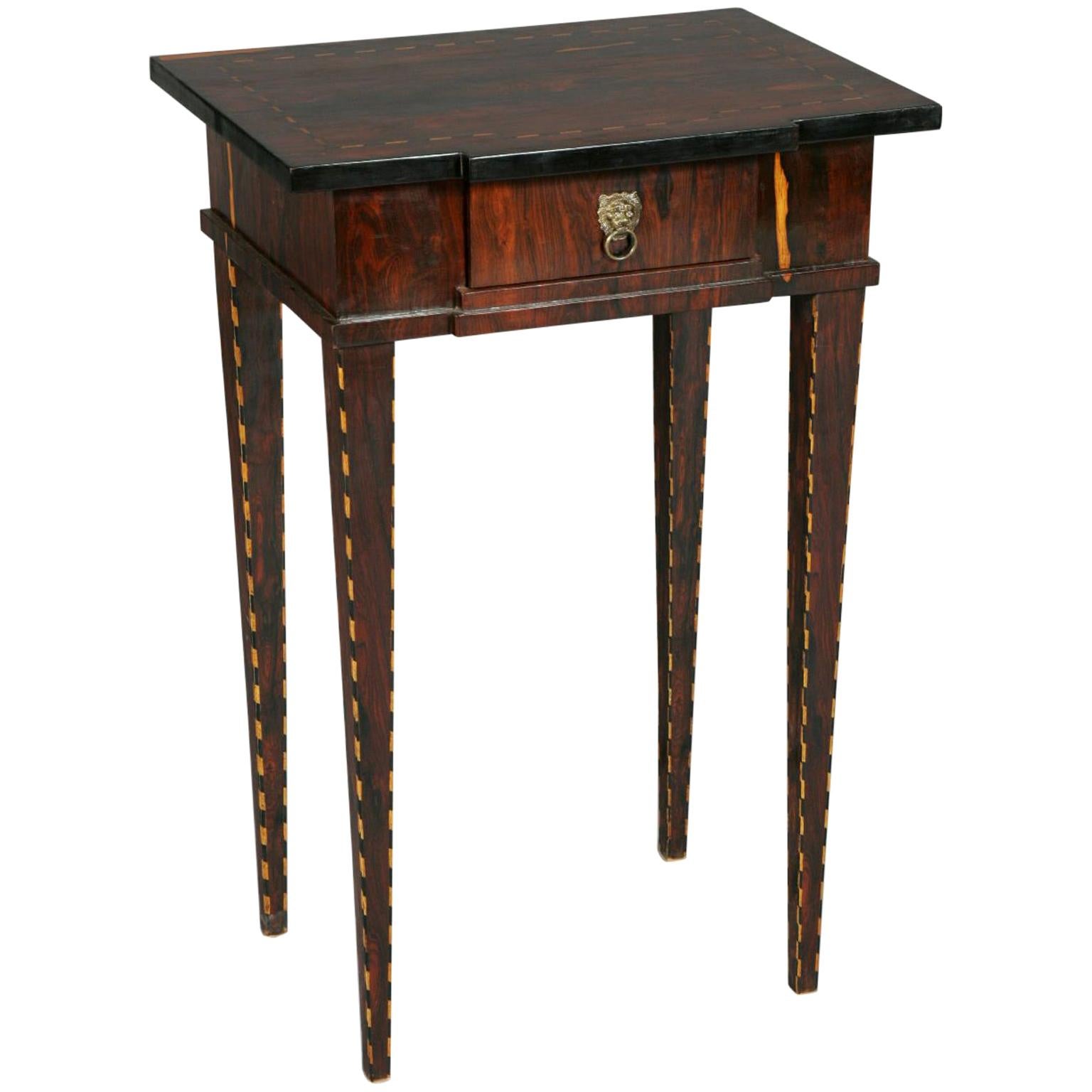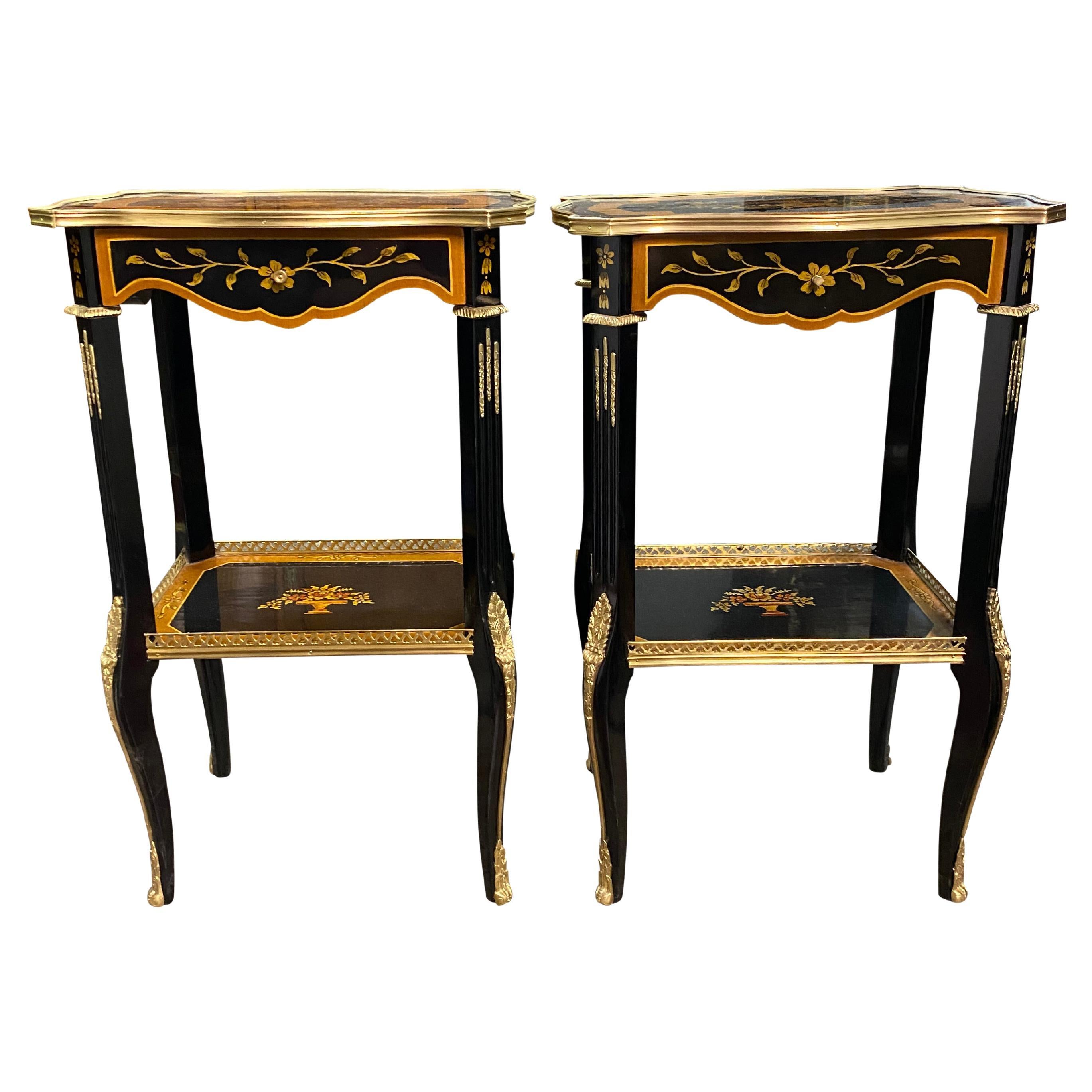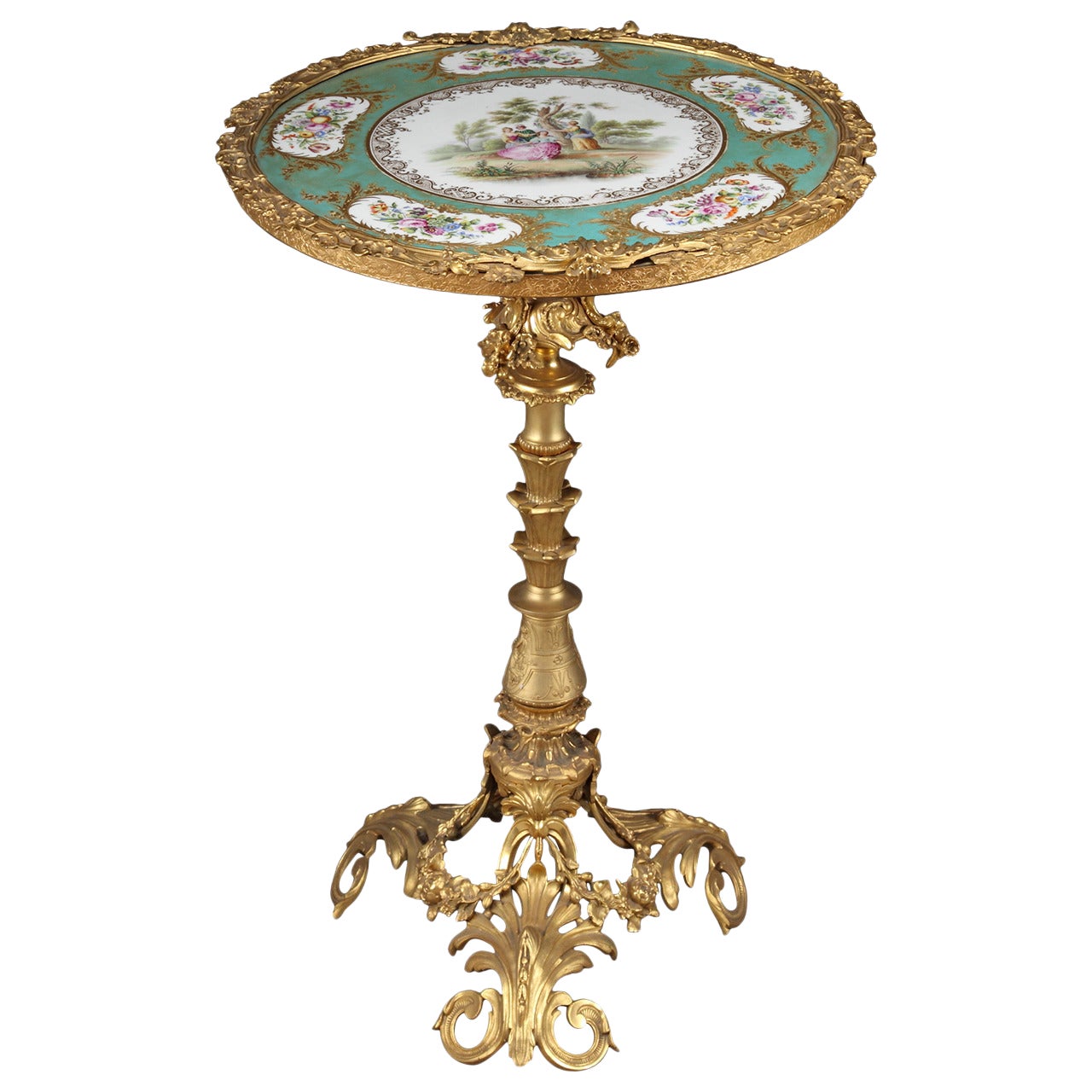Items Similar to Pair of French Ormolu & Sevres Style Porcelain Occasional Side Tables 20th C
Want more images or videos?
Request additional images or videos from the seller
Pair of French Ormolu & Sevres Style Porcelain Occasional Side Tables 20th C
About the Item
This is an exquisite pair of ormolu and Sevres style porcelain occasional tables in the fabulous Louis XVI manner dating from the late 20th century.
The circular gilded tops are each inset with a large central Sevre style porcelain plaque, surrounded by twelve smaller hand-painted circular plaques depicting bouquets of flowers and classical maidens on a bleu celeste ground. The top is supported on its hand-carved giltwood and walnut base.
It is a very decorative pair which will enhance any interior.
Condition:
In excellent condition, please see photos for confirmation.
Dimensions in cm:
Height 86 cm x Width 80 cm x Depth 80 cm
Dimensions in inches:
Height 2 foot, 10 inches x Width 2 foot, 7 inches x Depth 2 foot, 7 inches
Sevres Porcelain
traces its roots in France to early craftsmen who had small manufacturing operations in such places as Lille, Rouen. St. Cloud, and most notably Chantilly. It is from Chantilly that a cadre of workers migrated to the Chateau de Vincennes near Paris to form a larger porcelain manufactory in 1738.
French King Louis XV, perhaps inspired by his rumoured relationship with mistress Madame de Pompadour, took an intense interest in porcelain and moved the operation in 1756 to even larger quarters in the Paris suburb of Sevres. Sevres was also conveniently near the home of Madame de Pompadour and the King's own Palace at Versailles.
From the outset the king's clear aim was to produce Sevres Porcelain that surpassed the established Saxony works of Meissen and Dresden. Though the French lacked an ample supply of kaolin, a required ingredient for hard-paste porcelain (pate dure), their soft-paste porcelain (pate tendre) was fired at a lower temperature and was thus compatible with a wider variety of colours and glazes that in many cases were also richer and more vivid. Unglazed white Sevres Porcelain "biscuit" figurines were also a great success. However, soft-paste Sevres Porcelain was more easily broken. Therefore, early pieces of Sevres Porcelain that remain intact have become rare indeed.
The Sevres Porcelain manufactory always seemed to be in dire financial straits despite the incredibly fine works it produced. In fact, the king's insistence that only the finest items be created may have contributed to the difficulties. Only a limited number of European nobility could afford the extravagant prices demanded for such works. King Louis XV and eventually his heir, the ill-fated Louis XVI, were obliged to invest heavily in the enterprise. Ultimately, the Sevres Porcelain Factory produced items under the name of "Royal" and thus the well-known Sevres mark was born. King Louis XV even mandated laws that severely restricted other porcelain production in France so as to retain a near monopoly for his Sevres Porcelain. The king even willingly became chief salesman for the finest of his products, hosting an annual New Year's Day showing for French nobility in his private quarters at Versailles. He eagerly circulated among potential buyers, pitching the merits of ownership and policing the occasional light-fingered guest.
Sevres Porcelain may have indeed given the makers of Meissen and Dresden a run for their money by the end of the 18th Century but for the French Revolution. By 1800, the Sevres Porcelain Works were practically out of business due to the economic devastation of the new French Republic.
About the time when Napoleon Bonaparte named himself Emperor of France (1804), a new director was named for the Sevres Porcelain Manufactory. Alexandre Brongniart, highly educated in many fields, resurrected Sevres Porcelain. Soft-paste porcelain was eliminated altogether thanks to the earlier discovery of kaolin near Limoges. For four decades until his death, Brongniart presided over monumental progress for Sevres Porcelain, catering not only to Napoleon himself, but at last to include the more financially profitable mid-priced market in the emerging middle class.
Ormolu - (from French 'or moulu', signifying ground or pounded gold) is an 18th-century English term for applying finely ground, high-carat gold in a mercury amalgam to an object of bronze.The mercury is driven off in a kiln leaving behind a gold-coloured veneer known as 'gilt bronze'.
The manufacture of true ormolu employs a process known as mercury-gilding or fire-gilding, in which a solution of nitrate of mercury is applied to a piece of copper, brass, or bronze, followed by the application of an amalgam of gold and mercury. The item was then exposed to extreme heat until the mercury burned off and the gold remained, adhered to the metal object.
No true ormolu was produced in France after around 1830 because legislation had outlawed the use of mercury. Therefore, other techniques were used instead but nothing surpasses the original mercury-firing ormolu method for sheer beauty and richness of colour. Electroplating is the most common modern technique. Ormolu techniques are essentially the same as those used on silver, to produce silver-gilt (also known as vermeil).
Our reference: 08601
- Dimensions:Height: 33.86 in (86 cm)Width: 31.5 in (80 cm)Depth: 31.5 in (80 cm)
- Materials and Techniques:
- Period:
- Date of Manufacture:Circa 1980
- Condition:
- Seller Location:London, GB
- Reference Number:
About the Seller
5.0
Platinum Seller
These expertly vetted sellers are 1stDibs' most experienced sellers and are rated highest by our customers.
Established in 1983
1stDibs seller since 2012
1,205 sales on 1stDibs
Typical response time: 1 hour
Associations
LAPADA - The Association of Arts & Antiques Dealers
- ShippingRetrieving quote...Ships From: London, United Kingdom
- Return PolicyA return for this item may be initiated within 14 days of delivery.
More From This SellerView All
- Vintage Pair Regency Revival Brass Gallery Occasional Side End Tables 20th CLocated in London, GBThis is a handsome Vintage pair of Regency revival occasional tables. Masterfully created in gorgeous flame mahogany with brass galleries and elegant ormolu feet. They would be p...Category
Vintage 1980s English Regency Revival Side Tables
MaterialsBrass, Ormolu
- Early 20th Century Edwardian Triple Drop Flap Occasional Side TableLocated in London, GBThis is a unique stylish antique Edwardian specimen woods inlaid triangular drop flap occasional table, circa 1900 in date. The drop flaps can be raised to form a shaped circular to...Category
Antique Early 1900s English Edwardian Side Tables
MaterialsKingwood, Wood
- Early 20th Century Edwardian Inlaid Occasional TableLocated in London, GBThis is a delightful antique Edwardian mahogany and inlaid and crossbanded occasional table, circa 1900. This is a drop-leaf table which has a useful drawer with two brass handles. ...Category
Antique Early 1900s English Edwardian Side Tables
MaterialsMahogany
- Vintage Pair of French Louis Revival Ormolu Mounted Occasional Tables, 20th CLocated in London, GBThis is a beautiful pair of vintage French Louis Revival ormolu mounted side tables, mid-20th century in date. The square shaped "rosso levanto" marble tops are framed with decora...Category
Vintage 1950s French Tables
MaterialsMarble, Ormolu
- Early 20th Century Inlaid Mahogany Edwardian Occasional TableLocated in London, GBThis is a pretty antique Edwardian occasional table, circa 1900 in date. The table is exquisitely crafted in mahogany, features satinwood a...Category
Antique Early 1900s English Edwardian Side Tables
MaterialsMahogany
- Vintage Pair French Louis Revival Marble & Ormolu Occasional Tables 20th CLocated in London, GBThis is a beautiful pair of vintage French Louis Revival ormolu mounted side tables, mid 20th century in date. The shaped "Rosso Levanto Marble" marble tops are framed with ormolu...Category
Vintage 1950s French Tables
MaterialsMarble, Ormolu
You May Also Like
- 20th Century Louis XV Style French Occasional Side TableLocated in Berlin, DEExcellent French occasional table in Louis XV style. Highly valuable solid beechwood carved to the finest detail. Colored inlays and gilded. (G-Sam-25).Category
20th Century French Louis XV Side Tables
MaterialsWood, Beech
- 20th Century Classicist Style Occasional Side TableLocated in Berlin, DEOccasional table in Classicist style. Palisander on pinewood, framed fields of marquetry from band Intarsia. (G-Sam-20).Category
20th Century Neoclassical Side Tables
MaterialsWood, Pine
- Pair of French 20th Century Louis XVI Style Ormolu and Marble Side TablesLocated in West Palm Beach, FLA striking and extremely elegant pair of French 19th century Louis XVI st. ormolu and white Carrara marble gueridon side tables. Each gueridon is raised by handsome paw feet below li...Category
Antique 19th Century French Louis XVI Side Tables
MaterialsCarrara Marble, Ormolu
- Pair of 20th Century French Lacquer Style Side TablesLocated in Southall, GBA stunning pair of 20th century French Lacquer style side tables. A gorgeous and elegant design perfect for modern interiors.Category
20th Century European Side Tables
MaterialsWood
- Pair of 20th Century French Lacquer Style Side TablesLocated in Southall, GBA stunning pair of 20th century French Lacquer style side tables. A gorgeous and elegant design perfect for modern interiors.Category
20th Century European Side Tables
MaterialsWood
- French Louis XV Style Ormolu Bronze & Sevres Style Side TableLocated in Los Angeles, CACirca 1880 Origin: Paris Style: Louis XV Measures: Height: 32? (81cm) Diameter: 23? (58cm).Category
Antique 19th Century French Side Tables





